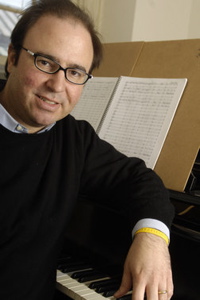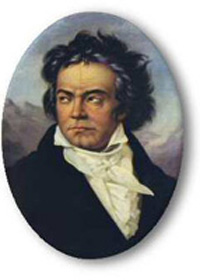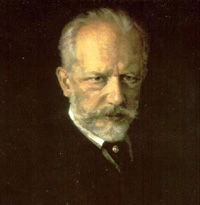| Beethoven and Blue Jeans | ||||||||||
Dreamtime Ancestors Born in Dallas, TX and a graduate of Yale, the Eastman School of Music, and the University of Houston, Christopher Theofanidis has been the recipient of the Masterprize, the Rome Prize, a Guggenheim Fellowship and the American Academy of Arts and Letters Charles Ives Fellowship, among others. He is a former member of the faculty of the Peabody Conservatory in Baltimore and the Juilliard School in New York City, and currently teaches at Yale. For the 2006-07 season he was composer-of-the-year of the Pittsburgh Symphony, during which he composed a violin concerto for Sarah Chang. According to the composer, Dreamtime Ancestors is a tone poem for orchestra that includes optional readings before each movement. It is based on the Australian aboriginal creation myths connected to “dreamtime,” when multiple generations, “dreamtime ancestors,” are connected to each other in the past, present, and future. This is referred to as “all-at-once time.” The work was commissioned by a consortium including the Western Michigan Symphony and will premiere this fall (2015). It is dedicated to the late composer Stephen Paulus, “a wonderful human being and music maker, who is a part of us of all, past, present, and future.” | ||||||||||
Symphony No. 1 in C major, Op. 21 Ludwig van Beethoven settled in Vienna in 1792, hoping to take the city by storm; but it took him several years to establish his credentials in this musically sophisticated city whose musical idol was the ageing Franz Josef Haydn. By the time Beethoven premiered the First Symphony on April 2 1800 at the Burgtheater his reputation was secure: he was well known as a pianist and in great demand as a soloist; his chamber and piano compositions had begun to attract serious attention and he had acquired numerous sponsors among the aristocracy and the well-to-do. He dedicated the First Symphony to one of them, the Baron van Swieten, a supporter and friend of Mozart, who had established a large library of music and promoted the music of Bach and Handel to Viennese audiences. The period of the First Symphony is also that of the Op. 18 String Quartets, and both represented important milestones for him as he sought to assimilate and surpass the achievements of Haydn in these two genres. The concert was a benefit for Beethoven in which he was featured both as performer and composer. The hefty program – by no means unusual for the time – included a Mozart symphony, two movements from Haydn’s Creation, an improvisation on the piano by Beethoven, the Septet, Op. 20, the Symphony No. 1 and probably the Piano Concerto in C major. Yet, despite Beethoven’s growing reputation, the critics' initial reception of the symphony was lukewarm at best, "...a caricature of Haydn pushed to absurdity." That absurdity was already apparent in the opening chords that trick the listener as to the true key of the piece,  which is definitively established in the Allegro. which is definitively established in the Allegro.  The third movement, although labeled "Minuet," dashes forward almost at a gallop with oddly placed forte outbursts, the first of Beethoven's symphonic innovations, the scherzo. The third movement, although labeled "Minuet," dashes forward almost at a gallop with oddly placed forte outbursts, the first of Beethoven's symphonic innovations, the scherzo.  If there’s a minuet at all in this work, it’s the lilting second movement, unusual also in that it begins as a fugue, in the strings, adding the other sections of the orchestra with each statement of the fugue subject. If there’s a minuet at all in this work, it’s the lilting second movement, unusual also in that it begins as a fugue, in the strings, adding the other sections of the orchestra with each statement of the fugue subject.  The humor of the stammering scale, plus another bit of tonal ambiguity in the introduction to the final movement, also went unappreciated. The Finale begins with a slow opening of a repeated partial scale in the violins, reaching one note higher with each repetition, until it suddenly bursts forth into a dance-like theme.  It is an opening worthy of Haydn at his most humorous. Like the Finale, the Minuet theme is also based on a rising scale motive. It is an opening worthy of Haydn at his most humorous. Like the Finale, the Minuet theme is also based on a rising scale motive. In a short time, however, the Symphony became a great favorite, "...a glorious production, showing extraordinary wealth of lovely ideas...". A measure of its popularity was the appearance only two years later of an anonymous pirated arrangement for piano quintet that elicited a nasty letter from Beethoven to the | ||||||||||
Piano Concerto No. 1 in B-flat minor, Op. 23 It is ironic that Tchaikovsky’s two most popular works, the First Piano Concerto and the Violin Concerto, were initially rejected by the greatest virtuosi of his country as unplayable fiascos. “...Utterly worthless, absolutely unplayable. Certain passages are so commonplace and awkward they could not be improved, and the piece as a whole was bad, trivial, vulgar.” This was the verdict of Nikolay Rubinstein, first director of the Moscow Conservatory and one of Tchaikovsky’s mentors, on hearing the composer play his new Piano Concerto on Christmas Eve 1874. The tirade raised Tchaikovsky’s hackles, and he refused to change a single note (although in later editions he made some minor modifications). But with Rubinstein’s negative opinion, he had little chance of mounting a respectable performance – or unbiased reception – in Russia. What has come to the most popular piano concerto by Russia’s most popular composer was premiered in Boston on October 25 1875, with a pick-up orchestra and famed pianist Hans von Bülow, where it was a smashing success. It is worth remembering that the First Piano Concerto came relatively early in Tchaikovsky's career. Rubenstein, the founder of the Moscow Conservatory, had served both as a mentor and first employer to the young composer. Moreover, Tchaikovsky's well-known bouts of depression and sense of alienation because of his homosexuality exacerbated his self-doubts about the quality of his music. It was a personal triumph, therefore, that he managed to withstand Rubinstein's vicious assault. Although the majestic introduction has become so well known as to be recognizable even to people unfamiliar with classical music, it was revolutionary for its time. It remains unlike any standard introduction in the orchestral repertory, replete with a fully developed theme and a cadenza. The four horns in unison play a four-note phrase that prefigures the opening theme, followed by the rest of the orchestra playing a series of chords which shift the key from B-flat minor to the relative major key, D-flat.  The piano enters with crashing chords that span more than six octaves and serve as the accompaniment of the introductory theme on the strings. The piano enters with crashing chords that span more than six octaves and serve as the accompaniment of the introductory theme on the strings.Introduced by a soft chordal transition, the exposition begins with a rhythmic figure that shifts the accent as the theme proper commences.  The melody is one Tchaikovsky allegedly heard a blind beggar sing at a country fair, but this theme too is hardly touched on again. As if the composer were searching for just the right melody to express his emotions, a sighing second theme in the winds The melody is one Tchaikovsky allegedly heard a blind beggar sing at a country fair, but this theme too is hardly touched on again. As if the composer were searching for just the right melody to express his emotions, a sighing second theme in the winds  and yet a third is added by the strings. and yet a third is added by the strings.  The development concerns itself largely with these two final themes, including wide mood swings that show off the pianist’s technical virtuosity. At one point Tchaikovsky combines the melody of the second theme in the horns with rhythm of principal theme in the upper winds. The development concerns itself largely with these two final themes, including wide mood swings that show off the pianist’s technical virtuosity. At one point Tchaikovsky combines the melody of the second theme in the horns with rhythm of principal theme in the upper winds.  The long cadenza is unusually restrained, a fine vehicle for highlighting the pianist’s control of pianissimo. The long cadenza is unusually restrained, a fine vehicle for highlighting the pianist’s control of pianissimo.The second movement opens with a gentle theme on the flute, accompanied by muted strings;  the theme is then taken up by the piano with just a single note change. Instead of maintaining the tempo for the middle section of the slow movement, Tchaikovsky quixotically launches into a tonally ambiguous (Lisztian, in fact) cadenza of pianistic pyrotechnics the theme is then taken up by the piano with just a single note change. Instead of maintaining the tempo for the middle section of the slow movement, Tchaikovsky quixotically launches into a tonally ambiguous (Lisztian, in fact) cadenza of pianistic pyrotechnics  as a lead-in to a melody based on a popular cabaret song of the time. as a lead-in to a melody based on a popular cabaret song of the time.  In the rondo finale Tchaikovsky again uses a folk tune in triple meter, but with the accent always on the second beat.  The violins introduce a second, broad lyrical theme for contrast, echoed in the piano. The violins introduce a second, broad lyrical theme for contrast, echoed in the piano.  As momentum towards the climax builds, the violins sneak in a hint of the main theme of the first movement. As momentum towards the climax builds, the violins sneak in a hint of the main theme of the first movement.  In place of a formal solo cadenza, an excited coda with lavish pianistic flourishes concludes the Concerto. In place of a formal solo cadenza, an excited coda with lavish pianistic flourishes concludes the Concerto.  It is probably fair to ask why this Concerto is such a popular competition piece. In keeping with the composer’s tumultuous emotional life, it requires of the performer a mastery of just about every artistic and technical resource: rapid passages in octaves, abrupt changes in mood, delicate passages of arpeggiated filigree, giant buildups of harmonic and emotional tension, whispered legato pianissimos. Is it any wonder Rubinstein overreacted? | ||||||||||
| Copyright © Elizabeth and Joseph Kahn 2015 | ||||||||||


